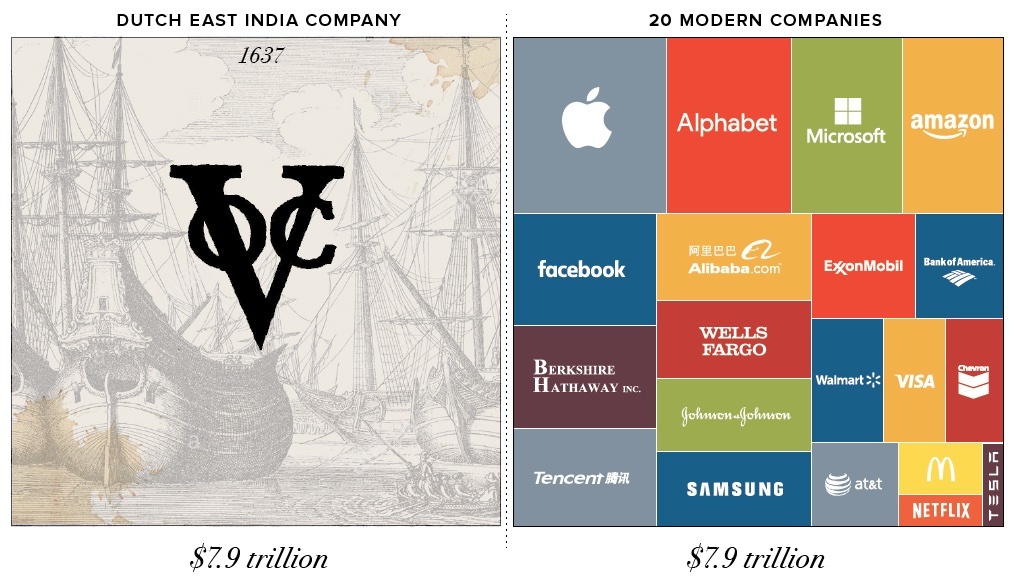Was the VOC the most valuable company ever? (Answer: NO!)
On August 19, 2020, the market capitalization of Apple crossed the $2 trillion mark (that’s $2,000,000,000,000). Apple is the world’s most valuable company right now. But is it also the most valuable company of all time?
The Saudi Arabian oil giant Saudi Aramco was briefly valued at $2.03 trillion when shares amounting to 1.5% of its capital began trading on the stock exchange of Saudi Arabia in December 2019. (At the time of writing, it is worth a lot less, due to the fact that the oil price plummeted after the corona virus outbreak in early 2020.) However, numerous websites claim that at some point in history various historical trading companies had a much higher value than Apple has reached in late 2020 of Saudi Aramco in December 2019.
A staggering $8.28 trillion
Howmuch.net, for example, writes that the English South Sea Company and Mississippi Company were worth $4.5 and $6.8 trillion at the height of the stock market craze of 1720. The most valuable company of all time, however, was the Dutch East India Company (VOC). According to howmuch.net, its worth reached a staggering $8.28 trillion in 1637. Lovemoney.com reports the same value and gives some more information: “The value of the company […] ballooned outrageously in 1634 after its ships carrying tulip bulbs sparked the infamous Tulip Mania in Holland. The value of the bulbs reached ridiculously high levels, pushing the company’s share price up 1,200%. Right before the bubble burst in 1637, the firm was worth 78 million Dutch guilders, which is $8.2 trillion (£6.3trn) in 2020 dollars, equivalent to the combined GDPs of Germany, the UK and France.”

Visualcapitalist.com, The Motley Fool, Business Insider, and also Dutch financial news network RTL Z—they all report more or less the same, impressive value of the VOC in 1637. But is it true?
Estimating the real value of the VOC
The short answer is: no. The value of the VOC doesn’t even come close to the likes of Apple and Saudi Aramco. Because the VOC did not publish financial reports (even though it was a listed company—the company argued that it was pointless to do so because shareholders wouldn’t be able to fathom the numbers anyway), and the company bookkeeper’s books have only partially survived and are very difficult to understand, the best way to estimate the company’s value is to look at market capitalization.
At its IPO in 1602, the VOC issued stock with a total value of 6,429,588 guilders. This amount stayed roughly the same until the company liquidated in the late 18th century. The highest share price was not reached 1637, but in 1720. In that year, a speculative frenzy spread from London to the European continent and VOC stock was briefly traded at around 1,200. The share price was expressed as an index figure, where the value of investments in 1602 was set at 100. So in 1720, the market capitalization of the VOC was just over 77 million guilders. That’s close to the value reported by Lovemoney.com, only the year is different. The share price of 1,200 for 1637 is simply wrong. At the height of the tulip craze, in early 1637, VOC shares traded around 270. Speculation with tulip bulbs, which was largely confined to a small group of traders in the Dutch city of Haarlem, did not have near as much impact on the VOC share price as the craze for shares in trading companies of 1720.
A meagre $1 billion
77 million guilders in 1720, how much would that be in today’s money? This is difficult to estimate, but according to this online tool of the International Institute for Social History (IISH) in Amsterdam, which uses a large series of consumer goods price data compiled by authoritative economic historians, it would be approximately €820 million (just short of $1 billion). That’s a factor 8,000 less than reported by many websites.
The IISH tool might underestimate historical inflation figures, but a value of around $8 trillion for the VOC is plainly ridiculous. In terms of company value, the VOC was the Apple of its time, but not of all time.


